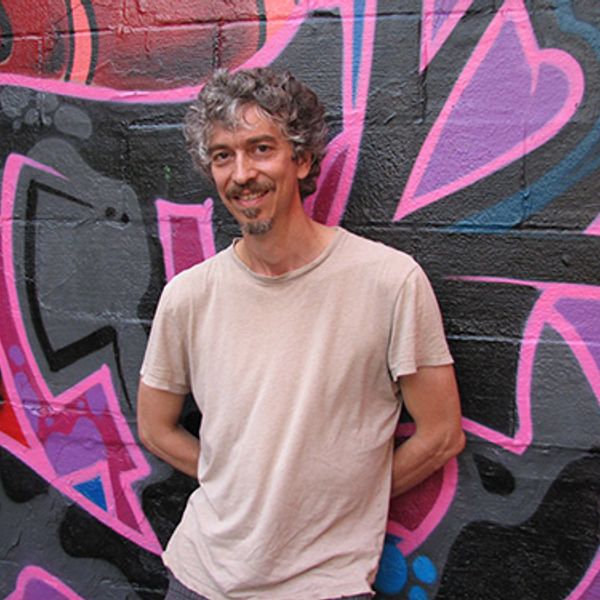Art by Jin Suk
The Visual Language of Victor Ekpuk
The art of Nigerian Victor Ekpuk, which E. C. Osondu and I selected to accompany The AGNI Portfolio of African Fiction, combines drawing, painting, sculpture, and a complex iconography of its own, to bring the past and present into a distinctly linguistic visual accord. “I express my ideas in pictographic writings,” Ekpuk writes. “The works in my Manuscript Series are good examples of that. These are on tablets originally used for writing prayers in Arabic or teaching Arabic in Islamic schools in sub-Saharan Africa. The works in this series are inspired by a combination of ancient Nigerian literary aesthetics, Nsibidi ideographs, and my pseudo-writings on Koran boards. So in essence they are stories, proverbs, prayers, and meditations—which gives them an affinity with writing that I believe makes these a good complement for AGNI.”
Beauty is in the Eye of the Beholder, 1998, from the Manuscript Series,
acrylic on wood, 21" x 12", © Victor Ekpuk
The link between storytelling and Ekpuk’s art carries into his paintings and drawings also. In works such as Market Day, Ekpuk seems to crisscross between vying forms of signification, as hieroglyphics have always done: the pictographs represent people gathered in magnificent diversity (and stirring alikeness), but they also imply sound, as if what we’re seeing is the cacophony of the marketplace, its mix of languages, chants, complaints, and hawkers’ cries. If there’s an unmistakable grandeur in Ekpuk’s invention of a language meant to hold the sweep of a continent—its history, its traditions—his work is always cut through with humility. Supplication, dailiness, the worn-down surface: here, the gathered meet under a demanding sun, which rewrites those white spaces between as sweat.
Market Day, 2005, pigment ink and china marker
on paper, 44" x 60", © Victor Ekpuk
Another telling recurrence in Ekpuk’s art is the red dot, with its resemblance to the Hindu tilaka: the dot worn on the forehead to represent a third eye turned inward toward God. In Children 0f the Full Moon, as elsewhere in Ekpuk, the dot focuses the viewer on a single part of the work, turning us toward the individual found in the mass. In some of his paintings, the dot seems arrived at, risen to, as if the group has struggled to put forward the one example. In others, as here, the dot is both a continuation of what surrounds it and a wholly different thing: this one is formed of several smaller dots that resemble nothing so much as seeds—the founding unit that makes the riot of voices possible.
Children of the Full Moon, 2005, pastel and acrylic ink
on pigment print, 42" x 42", © Victor Ekpuk
It’s as if Ekpuk were saying to us, in the context of the portfolio, that the phoneme, the utterance, the individual attempt is sacred—that the thing risen toward is also the thing risen from, that a whole culture and way of life, a cabal of language-sharers (artistic, pragmatic; spoken, felt), strives forward with each rising up, whether a rising to proclaim, to beseech, to attack, to rebuild, to escape, or to honor.
Yet the individual then stands alone, responsible. Answerable to the larger whole. In Fortune Teller (the image on the cover of AGNI 72, where the print half of the Africa portfolio can be found), a right hand, perhaps the hand of a child, holds a red dot in its palm—a pile of grain, maybe, or food of some other sort. Food for the spirit? This time the dot is formed of pictographs: the stories of others, passed down, shared forward, husbanded, and then, in an open palm, offered up, back again to the many.
For more of Ekpuk’s work, order AGNI 72. You can also visit his website at www.victorekpuk.com.

William Pierce
William Pierce is editor of AGNI. His short stories have appeared in Granta, Ecotone, American Literary Review, and elsewhere. Excerpts from his novel Twenty Sixteen can be found in Harvard Review, The Western Humanities Review, and on the Freeman’s channel at Literary Hub. His translations of fiction have appeared or are forthcoming in Little Star and New England Review; other work of his own, in Electric Literature, The Writer’s Chronicle, Solstice, The Continental, Consequence, and as part of MacArthur Fellow Anna Schuleit Haber’s art project “The Alphabet,” commissioned by the Fitchburg Art Museum. Pierce is the author of Reality Hunger: On Karl Ove Knausgaard’s My Struggle (Arrowsmith Press, 2016), a monograph first serialized as a three-part essay at The Los Angeles Review of Books. More at williampiercewriter.com. (updated 11/2025)
His first essay for AGNI, “Fabulously Real,” received special mention in the 2006 Pushcart Prize anthology. His introduction to AGNI 91, “The Peculiarities of Literary Meaning,” was cited in the 2022 Pushcart anthology, and his introductions to AGNI 98 and AGNI 100 were Notables in The Best American Essays. He is interviewed here at NewPages.com. With E. C. Osondu, he coedited The AGNI Portfolio of African Fiction.



